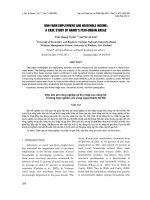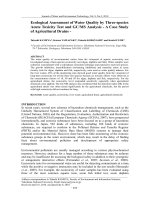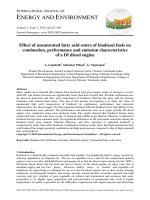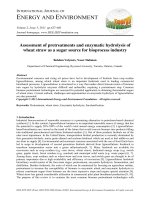Jatropha curcas oil: A future source of biodiesel
Bạn đang xem bản rút gọn của tài liệu. Xem và tải ngay bản đầy đủ của tài liệu tại đây (215.05 KB, 24 trang )
Jatropha curcas oil: A future source of
biodiesel
By
Siddharth Jain
INDIAN INSTITUTE OF TECHNOLOGY ROORKEE
ROORKEE-247 667
INDIA
Presentation
on
Contents
Introduction
Vegetable Oil Resources for Biodiesel Production
Methods for modification of straight vegetable oil
Performance Evaluation of Diesel Engine Using Biodiesel
Stability of biodiesel
Conclusion
Total crude oil consumption of the country is 184.68 MT in 2007-08.
Out of which 80% of the total demad is imported.
Import value is 6,06,800 crore.
Crude oil is also creating environmental problems.
Therefore there is need to go for substitute of petroleum diesel.
Substitute of petroleum diesel:
Straight vegetable oil
Edible oils
Non edible oils
72.5 % of the total edible oil demand is importing in the country.
OBJECTIVE OF STUDY
To study the fossil fuel scenario with respect to petroleum
diesel, fuel properties of biodiesel resuorces for biodiesel
production, process for its production, etc.
Study the effect of biodiesel on the performance of IC engine
To study the oxidation stability of biodiesel.
WHY JATROPHA
Jatropha can be grown in arid zones (20 cm rainfall) as well as in higher rainfall
zones & even on land with their soil cover.
Under the national biodiesel program Jatropha is selected to fulfill the national need
of biodiesel.
Upto 2012 government is planning to substitute biodiesel from jatropha in
commercial use (20% of the total petroleum diesel ).
Jatropha specie is scientifically developed to give maximum yield.
It is a quick yielding species even in adverse land situations viz degraded & barren
lands under forest & non forest use, dry and drought prone area, marginal lands
even an alkaline soils & also as agro forestry crops.
Jatropha removes carbon from the atmosphere stores it in the woody tissues &
assists in the build up of soil carbon.
Various parts of the plant are of medicinal value.
Biodiesel and land requirement in India
Year Diesel
demand
(MT)
Biodiesel
requirement (MT)
Seed requirement
(MMT)
Area requirement
(Mha)
BD
5
BD
10
BD
20
BD
5
BD
10
BD
20
BD
5
BD
10
BD
20
2007-08 60.18 3.01 6.02 12.0 10.0 20.0 40.1 5.01 10.0 21.0
2008-09 90.27 4.51 9.03 18.0 15.0 30.1 60.1 7.52 15.0 30.0
2009-10 95.23 4.76 9.52 19.0 15.8 31.7 63.5 7.94 15.8 31.7
2010-11 100.47 5.02 10.0 20.1 16.7 33.5 66.9 8.37 16.7 33.5
2011-12 106.00 5.30 10.6 21.2 17.6 35.3 70.6 8.83 17.6 35.3
2012-13 111.83 5.59 11.1 22.3 18.6 37.2 74.5 9.32 18.6 37.2
2013-14 117.98 5.90 11.8 23.6 19.6 39.3 78.6 9.93 19.6 39.3
2014-15 124.47 6.22 12.4 24.9 20.7 41.5 82.9 10.3 20.7 41.5
2015-16 131.31 6.57 13.3 26.2 21.9 43.7 87.5 10.9 21.9 43.7
2016-17 138.54 6.93 13.8 27.7 23.1 46.1
92.6 11.5 23.1 46.1
2017-18 146.16 7.31 14.6 29.2 24.3 48.7 97.4 12.1 24.3 48.7
2018-19 154.19 7.71 15.4 30.8 25.7 51.4 102 12.8 25.7 51.4
2019-20 162.67 8.13 16.2 32.5 27.1 54.2 108 13.5 21.1 54.2
Land area under cultivation of jatropha in various states
State Area (ha) % of total land
Andhra Pradesh 260 2.63
Bihar 110 1.11
Chattisgarh 650 6.58
Delhi 665 6.63
Gujarat 1140 11.54
Goa 10 0.10
Haryana 520 5.26
Jharkhand 200 2.02
Karnataka 120 1.21
Kerala 50 0.5
Madhya Pradesh 84 0.85
Maharashtra 1310 13.26
Manipur 200 2.03
Meghalaya 200 2.03
Mizoram 300 0.30
Nagaland 240 2.43
Rajasthan 715 7.24
Tamilnadu 960 9.72
Uttar Pradesh 633 6.41
Uttarakhand 650 6.58
West Bengal 100 1.01
Total 9878 100
JATROPHA PLANTATION
Productivity of Jatropha plantation
S.No
Seeds/ hactare
(MT)
Oil /
hectare
(MT)
Biodiesel/ hectare
(MT)
Cost of plantation/
hectare (Rs)
1 4-6 1.5-2 1.35- 1.8 20000
Methods of using straight vegetable oil as fuel:
As oil
As modified oil
Problems of using oil directly in engine
High viscosity
Low calorific value
Fuel Properties of Vegetable Oil
Vegetable
oils
Cetan
number
Heating
valu
es
(MJ/
kg)
Cloud
point
(
0
C)
Pour
point
(
0
C)
Kinematic
viscosit
y (cSt
@
38
0
C)
Flash
point
Specific
gravi
ty @
15
0
C
Corn 37.6 39.5 -1.1 -40.0 34.9 277 0.9095
Cottonseed 41.8 39.5 1.7 -15.0 33.5 234 0.9148
rapeseed 37.6 39.7 -3.9 -31.7 37.0 246 0.9115
Safflower 41.3 39.5 18.3 -6.7 31.3 260 0.9144
Sesame 40.2 39.3 -3.9 9.4 35.5 260 0.9133
Soybean 37.9 39.6 -3.9 -12.2 32.6 254 0.9138
Sunflower 37.1 39.6 7.2 -15.0 33.9 274 0.9161
Palm 42.0 39.5 31.0 - 39.6 267 0.9180
Jatropha 40-45 39-40 - - 55@ 30
0
C 240 0.912
Diesel 40-55 42 -15 to -5 -33 to -15 1.3-4.1 60-80 0.82-
0.86
Factors affecting the transesterification reactions
Reaction temperature.
Ratio of alcohol to vegetable oil.
Catalyst.
Mixing intensity.
Purity of reactants.
EXPERIMENTAL SETUP
Parameters measured for Biodiesel Preparation
Parameters Jatropha Oil Methyl
Ester
Acid Base
Time (min) 180 180
Temp (
0
C) 65 55
RPM 400 400
Methyl Ester Amount
(%)
30 30
Yield (%) 21.5039 90.21
Catalyst H
2
SO
4
KOH
Methanol to oil Ratio
(v/v)
30:70 30:70
S.No. Properties Jatropha oil
1 Net calorific value (MJ/kg) 36.01
2 Flash point (
0
C) 242
3 Viscosity (cSt, @ 30
0
C) 51
4 FFA (%) 17.84
5 Density (kg/m
3
@ 15
0
C) 932
Properties of Jatropha oil
BASIC REQUIREMENT FOR A FUEL FOR IC ENGINE
High energy density.
Good combustion qualities.
High thermal stability.
Low deposit forming tendencies.
Compatibility with the engine hardware.
Good fire safety.
Low toxicity.
Low pollution.
Easy transferability and onboard vehicle storage.
Variation in BSFC with Load for Different Blends of Jatropha Biodiesel with Diesel
Variation in BTE with Load for Different Blends of Jatropha Biodiesel with Diesel
COMPARISION OF EMISSIONS FROM BIODIESEL AND DIESEL
S.No. Emission type B
100
B
20
1 Hydrocarbon (HC) -67% -20%
2 CO -48% -12%
3 Particulate matter (PM) -47% -2%
4 NO
X
+10% +2%
5 SO
2
-100% -20%
6 PAH -80% -13%
The Specification of Biodiesel and Diesel
Fuel
Properties
Jatropha Oil Jatropha
Biodiesel
Diesel BIS Standards
for Biodiesel
Net calorific
value (MJ/kg)
36.01 37.1 42 37.12
Flash point (
0
C) 242 192 60-80 130 (minimum)
Viscosity (cSt,
@ 30
0
C)
51 5.3 2.6 1.9-6.0
Acid value
(mgKOH /g)
17.84 0.42 0.09 0.8
Density (kg/m
3
@ 15
0
C)
932 887 - 880
Perameters required to measure the oxidation stability
Peroxide value
Iodine value
FFA contents
Induction period
Viscosity
Flash point
Cloud point
Pour point
Saponoficatiuon value
Oxxxxxxxx xxxxxxxxx
S.No. Name of antioxidant Abbreviation
1 Pyrogallol PY
2 Gallic Acid GA
3 Propyl Gallate PG
4 Catechol C
5 Nordihydroguaiaretic acid NDGA
6 2-t-butyl-4-methoxyphenol BHA
7 2,6-di-t-butyl-4-methylphenol BHT
8 t-butyl hydroquinone TBHQ
Antioxidants used for stabilizing the biodiesel
CONCLUSIONS
Biodiesel is an ecofriendly and renewable fuel substitute of diesel.
Research has indicated that upto B20, there is no need of modification in
engine.
The engine performance evaluation has found that brake specific fuel
consumption for B100 was 14.8% higher than diesel for biodiesel from Jatropha
oil at full load, thereby indicating the use of 100% biodiesel can produce same
output of energy using higher amount of biodiesel and therefore deserve to
become the “On Farmer Fuel” where farmer can grow his own resource,
convert to biodiesel and use in agricultural sets itself without the need of any
diesel for blending.
The brake thermal efficiency is found higher upto B30 in comparison to diesel
while BTE of B100 (24%) was almost equals to diesel (24.5%) for JOME.
The basic problem with biodiesel is that it is more prone to oxidation resulting
in the increase in viscosity of biodiesel with respect to time which in turn leads
to piston sticking, gum formation and fuel automization problems.
Thanks









